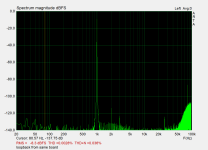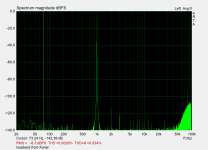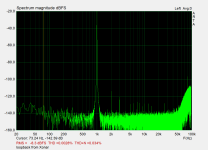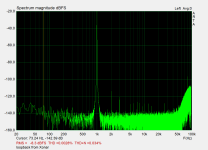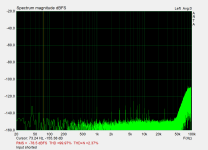My best measurement for linearity funcion... any setup more refined that that provokes some aberrations in the sweep (a zig-zag response, but from the ARTA).

For the possible resolution, is not possible to see any big bump (only some small ones at low levels). And here is the DAC with variable noise floor.
In fact, the AVcc with TL431 are not up to task: I can see it's noise with a simple 20MHz scope in the 5mV scale. I understant that needs to be invisible to the scope, for the ES sake, like the low noise shunt's I made, or the recommended regs. I will try my low noise shunts when I move these board for another equipment.
For the possible resolution, is not possible to see any big bump (only some small ones at low levels). And here is the DAC with variable noise floor.
In fact, the AVcc with TL431 are not up to task: I can see it's noise with a simple 20MHz scope in the 5mV scale. I understant that needs to be invisible to the scope, for the ES sake, like the low noise shunt's I made, or the recommended regs. I will try my low noise shunts when I move these board for another equipment.
Can you share your existing TL431 circuit? There are some tricks that can get its noise way down.
Is pretty much like the ones from the figure in the post #9240, page 462, from this thread: https://www.diyaudio.com/community/...ltimate-nos-dac-using-tda1541a.79452/page-462
But I use 10µF instead of 100µF for the feedback coupling one, and 100R instead the 510R shor there for the B-E junction of the output transistor (BD140 in this figure).
Aka. the typical buffered TL431.
CCS I use a good one (discrete), with great results elsewhere.
But I use 10µF instead of 100µF for the feedback coupling one, and 100R instead the 510R shor there for the B-E junction of the output transistor (BD140 in this figure).
Aka. the typical buffered TL431.
CCS I use a good one (discrete), with great results elsewhere.
While a buffered TL431 works its not particularly quiet. To get low noise you need to isolate it as a voltage reference and use a different technique for the series pass or shunt. I used a large RC filter and then a sziklai pair which are low noise if executed well. The series regulator was in the 1-2 nV/rtHz range (I had to build special LNA to measure it). Here is a link to some discussion: https://www.diyaudio.com/community/...sb-interface-audio-widget.185761/post-3418158
Interesting. Besides, the TL431 not have super large frequency response; is not as fast as some discrete propositions. But TL are faster than the LM317 dinosaur.
I already use discrete shunts for clock supply and another DAC's where have some benefits, sucessfully. In fact, these shunts are simple and rely on the noise of the reference (since it are not decoupled), so I need to use things like IR LED, low voltage true zener or LED's.
They are in fact ridiculous simple, are a kind of a Sziklay-buffered reference ("buffered Zener"-like). The internal impedance results only a bit higher the the TL, but extends higher, are far faster in response, and is less noisy (noise floor 20dB lower). The tempco is surprisingly low; suffices for maintain securely and safe in the working voltage range of any target IC I used.
This DAC is from the time I not tried these yet (years ago).
Since I have the parts of hand for making the this shunt, I try it to see if it suffices to make the ES happy (or at least undetectable in the target system use). If not, I try something along your tips.
I already use discrete shunts for clock supply and another DAC's where have some benefits, sucessfully. In fact, these shunts are simple and rely on the noise of the reference (since it are not decoupled), so I need to use things like IR LED, low voltage true zener or LED's.
They are in fact ridiculous simple, are a kind of a Sziklay-buffered reference ("buffered Zener"-like). The internal impedance results only a bit higher the the TL, but extends higher, are far faster in response, and is less noisy (noise floor 20dB lower). The tempco is surprisingly low; suffices for maintain securely and safe in the working voltage range of any target IC I used.
This DAC is from the time I not tried these yet (years ago).
Since I have the parts of hand for making the this shunt, I try it to see if it suffices to make the ES happy (or at least undetectable in the target system use). If not, I try something along your tips.
I quick dirt tested my ES DAC using only one output of it, since I removed it from headphones amp. Difficult to measure, since the high impedance in pure voltage mode not helps with airborne noise and long unshielded cables (no enough time to get fancy for now) :-( Even so, I noted the absence or very reduced of tilting with low frequencies:

Better now. The 10-20kHz bump moves when I get near the cables, along with mains noise.

So I have hope for it when I fully install it in it's new application. The system that will receive it have analog volume and not needs a ultra low noise floor.
Intriging is the 41Hz interference...

Input of gig shorted.
Better now. The 10-20kHz bump moves when I get near the cables, along with mains noise.
So I have hope for it when I fully install it in it's new application. The system that will receive it have analog volume and not needs a ultra low noise floor.
Intriging is the 41Hz interference...
Input of gig shorted.
